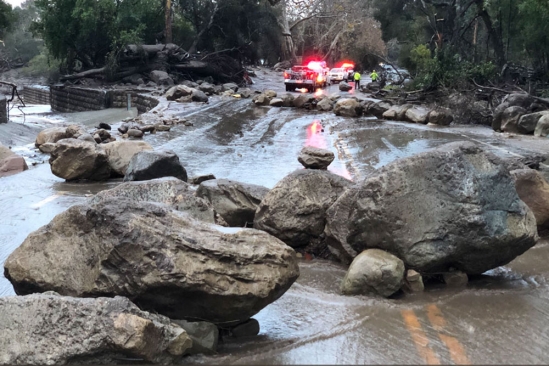The Perfect Storm
Imagine someone hands you a jar of marbles, each marked with a number from 1 to 200, and instructs you to reach in and extract only the one marked 200. What are the chances you would pull out that exact marble?
Speaking to an audience that packed the Santa Barbara Library’s Faulkner Gallery Thursday, Jan. 25, UC Santa Barbara geologist Ed Keller used that analogy — and those slim odds — to describe the kind of storm that decimated large swaths of Montecito in the early morning hours of Jan. 9. Unable to absorb the sheer amount of water the storm dumped in only a few minutes, the fire-ravaged foothills crumbled and a raging river of mud, silt, rock and debris flowed toward the sea. It swallowed up everything in its path — homes, cars, infrastructure and people.
“These really big events are relatively rare in any one place,” Keller said of the devastating debris flow that was brought on by intense rain in the wake of the historic Thomas Fire. Fires and floods each have occurred periodically, in their own cycles, but their effects and material accumulate, Keller explained. And once in a great while they sync up, causing the kind of flow that fills creeks, clogs debris basins and mows down everything in its path. One such flow, he added, is responsible for the boulder field at Rocky Nook Park in Mission Canyon. That catastrophic debris flow occurred about a thousand years ago.
Floating Boulders
Boulders played a huge part in the destruction wrought by the Jan. 9 disaster. Enormous rocks that in Keller’s “before” photos seemed cemented into creek beds were scattered by a 30-mph flow of viscous silt — the finest grains of sediment — as shown in the “after” images. This silt was loosened by the wildfire that destroyed the already drought-parched roots that would have helped hold the hills in place. Adding to that, the hydrophobic soil that resulted from wax released by burning chaparral helped to accelerate the flow, which lifted and pushed the huge stones. At roughly 120 pounds per cubic foot, Keller pointed out, the density of the sediment flow was comparable to the boulders themselves (roughly 150 pounds per cubic foot).
According to Keller, that explains why these boulders with the viscous fluid appeared to float down the creek.
Meanwhile, rocks, sediment and everything else carried along in the flow clogged drainage pipes and debris basins, and gathered under bridges. With nowhere else to go, the flow rose over the top of the accumulated debris, sending more water and mud and boulders toward roads and streets and other houses and buildings in Montecito’s business corridor.
Alluvial Fans
Topography is another major factor in the likelihood of these flooding events. Historically, Montecito, and Santa Barbara in general, are sites for these debris flows. The aerial images in Keller’s presentation showed canyons funnelling into alluvial fans at the base of the hills — cone-shaped features that indicate the presence of debris flows upon debris flows. Montecito looked to be virtually all alluvial fans — as did Santa Barbara, though to a slightly lesser degree.
“Basically they extend from the foothills all the way down to the coast,” said geologist Larry Gurrola, a member of Keller’s team who also gave a presentation.
Keller, who with his research colleagues has been examining the sites of the flood, acknowledged the tragedy and the difficulty for people who have lost so much in such a brief period of time. Because an event of this magnitude is so rare and unpredictable, it’s challenging to know how to plan and build with enough foresight for such disasters. Historical photos of Montecito showed that the few people living in the area some 100 years ago generally avoided the creeks, whereas some homes destroyed by the recent flow were built mere feet from them.
Keller and his research team hope to investigate the likelihood of more boulders crashing down the hillsides into the urban areas should another big storm hit. They also seek to explore the somewhat erratic behavior of the Jan. 9 debris flow, which seemed to have covered more area — spreading laterally — than would have been predicted.
In the meantime, the scientists are monitoring the situation and consulting with and educating the community about the sometimes less-than-solid earth upon which we stand. The soil situation will remain sketchy for at least a year or two, Keller said, until the vegetation in the hills recovers enough to hold dirt and sediment in place, and the soils become less water-repellent. The odds of another “one-two-three punch” may also change, given the climate.
Hi! I am a robot. I just upvoted you! I found similar content that readers might be interested in:
http://www.news.ucsb.edu/2018/018677/perfect-storm